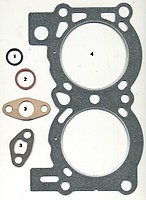
Photo from wikipedia
Joint surface morphology has essential implications for joint shear behaviors. In this paper, constant normal load (CNL) direct shear tests were performed on 150 artificial rock joint specimens to study… Click to show full abstract
Joint surface morphology has essential implications for joint shear behaviors. In this paper, constant normal load (CNL) direct shear tests were performed on 150 artificial rock joint specimens to study the joint surface degradation process under various initial joint roughness coefficient (JRC initial ), joint wall compressive strength (JCS), and normal stress ( σ n ) values. The experimental results revealed that with increases in JRC initial , JCS, and σ n , the joint surface exhibited different levels of increased degradation. With increasing shear displacement, the JRC continued to decline and finally tended to stabilize to a constant value, and we divided the degradation process into an initial weakening phase, a rapid weakening phase, and a constant weakening phase. Based on regression analyses, a JRC degradation model was presented to evaluate the JRC values of rock joints under various displacements, and a new empirical equation was introduced to predict peak shear displacement. Additionally, a piecewise function for the different shear displacement stages was proposed to calculate JRC mobilized by replacing JRC in the JRC–JCS model, and the variation in the friction angle $$\phi$$ ϕ at various stages was discussed. Finally, a modified constitutive model was developed to predict shear strength versus displacement curves. The predicted results indicated that the new proposed model performs better than previous models.
Journal Title: Rock Mechanics and Rock Engineering
Year Published: 2020
Link to full text (if available)
Share on Social Media: Sign Up to like & get
recommendations!